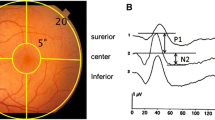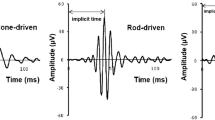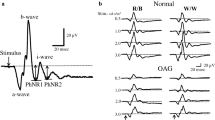Abstract
We evaluated the effects of retinal diseases on the macular electroretinogram first and second harmonic components, which are dominated by outer and inner retinal activity, respectively. Macular electroretinograms in response to a uniform field (9° × 9°) flickering sinusoidally at either 32 or 8 Hz (peak frequencies of the first and second harmonics, respectively) were recorded in 14 patients with maculopathies involving photoreceptors (e.g., age-related macular degeneration), in 16 patients with postreceptoral macular diseases (e.g., branch occlusion of central retinal artery), and in 38 normal controls. Amplitude and phase of the first and second harmonic response components were evaluated by Fourier analysis. When compared to controls, patients with photoreceptor diseases had reduction in both first and second harmonic mean amplitudes and second harmonic phase delay; patients with postreceptoral diseases had normal first harmonic components but reduced and delayed second harmonic components. A discriminant analysis, by using first and second harmonic values, correctly classified 13 of 14 patients with photoreceptor diseases and 14 of 16 patients with postreceptoral disorders. These results indicate that combined evaluation of the macular electroretinogram first and second harmonic components is a useful test for identifying the site(s) of retinal dysfunction in patients with macular diseases.
Similar content being viewed by others
Abbreviations
- MANOVA:
-
multivariate analysis of variance
- SD:
-
standard deviation
References
Miyake Y. Layer-by-layer analysis of macular diseases with objectively measured visual functions. Jpn J Ophthalmol 1990; 34: 225–38.
Miyake Y, Miyake K, Shiroyama N. Classification of aphakic cystoid macular edema with focal macular electroretinograms. Am J Ophthalmol 1993; 116: 573–83.
Miyake Y, Shiroyama N, Ota I, Horiguchi M. Focal macular electroretinogram in X-linked congenital retinoschisis. Invest Ophthalmol Vis Sci 1993; 34: 512–5.
Seiple WH, Siegel IM, Carr RE, Mayron C. Evaluating macular function using the focal ERG. Invest Ophthalmol Vis Sci 1986; 27: 1123–30.
Porciatti V, Falsini B, Fadda A, Bolzani R. Steady-state analysis of the focal ERG to pattern and flicker: relationship between ERG components and retinal pathology. Clin Vision Sci 1989; 4: 323–32.
Abraham FA, Alpern M, Kirk DB. Electroretinograms evoked by sinusoidal excitation of human cones. J Physiol 1985; 363: 135–50.
Odom JV, Reits D, Burgers N, Reimslag FCC. Flicker electroretinograms: a system analytic approach. Opt Vision Sci 1992; 69: 106–16.
Burns SA, Elsner AE, Keitz MR. Analysis of nonlinearities in the flicker ERG. Opt Vision Sci 1992; 69: 95–105.
Baker CL, Hess RF, Olsen BT, Zrenner E. Current source density analysis of linear and non-linear components of the primate electroretinogram. J Physiol (Lond) 1988; 407: 155–76.
Porciatti V, Falsini B. Inner retina contribution to the flicker electroretinogram: a comparison with the pattern electroretinogram. Clin Vision Sci 1993; 8: 435–47.
Brindley GS, Westheimer G. Spatial properties of the human electroretinogram. J Physiol 1965; 179: 518–37.
Baker CL, Hess RF. Linear and nonlinear components of human electroretinogram. J Neurophysiol 1984; 51: 952–67.
Fiorentini A, Maffei L, Pirchio M, Spinelli D, Porciatti V. The ERG in response to alternating gratings in patients with diseases of the peripheral visual pathway. Invest Ophthalmol Vis Sci 1981; 21: 490–3.
Sandberg MA, Jacobson SG, Berson EL. Foveal cone electroretinogram in retinitis pigmentosa and juvenile macular degeneration. Am J Ophthalmol 1979; 80: 702–7.
Biersdorf WR. The clinical utility of the foveal electroretinogram: a review. Doc Ophthalmol 1990; 73: 313–25.
Seiple WH, Holopigian K, Greenstein VC, Hood DC. Sites of cone system sensitivity loss in retinitis pigmentosa. Invest Ophthalmol Vis Sci 1993; 34: 2638–45.
Falsini B, Colotto A, Porciatti V, Buzzonetti L, Coppè A, De Luca LA. Macular flicker-and pattern E R Gs are differently affected in ocular hypertension and glaucoma. Clin Vision Sci 1991; 6: 422–9.
Falsini B, Bardocci A, Porciatti V, Bolzani R, Piccardi M. Macular dysfunction in multiple sclerosis revealed by steady-state flicker and pattern E R Gs. Electroencephalogr Clin Neurophysiol 1992; 83: 53–9.
Miyake Y, Shiroyama N, Ota I, Horiguchi M. Local macular electroretinographic responses in idiopathic central serous chorioretinopathy. Am J Ophthalmol 1988; 106: 546–50.
Fish GE, Birch DG. The focal electroretinogram in the clinical assessment of macular disease. Ophthalmology 1989; 96: 109–14.
Author information
Authors and Affiliations
Rights and permissions
About this article
Cite this article
Falsini, B., Porciatti, V., Fadda, A. et al. The first and second harmonics of the macular flicker electroretinogram: Differential effects of retinal diseases. Doc Ophthalmol 90, 157–167 (1995). https://doi.org/10.1007/BF01203335
Accepted:
Issue Date:
DOI: https://doi.org/10.1007/BF01203335




